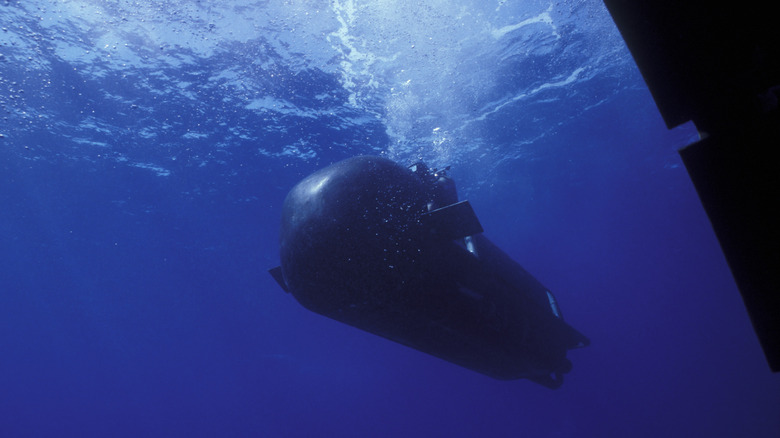This Mini Sub Is Built To Sneak Navy SEALs Into Enemy Territory
Navy SEALs are known for operating under the radar. They are an elite and highly-trained military force that specializes in conducting secretive missions, including insertions and extractions, often deep into enemy territory. Achieving this without being detected is largely determined by the nature of the mission, but one method that has been used for decades is the use of mini submarines. However, while this has been a common method for SEALs to deploy, it isn't without its drawbacks.
Operating such mini-submarines meant that SEALs would be exposed to the elements, and would have to don wetsuits to keep dry and warm during deployments. This meant that SEALs (SEAL stands for sea, air, and land) would often arrive on missions in less than top physical condition. And while Navy SEAL training means only the fittest make it through, being cold and wet will still sap performance.
This is why the latest tool available to Navy SEALs is so important. The Dry Combat Submersible (DCS) is designed to clandestinely deliver SEALs over long distances to their destination in a completely dry environment. According to Lockheed Martin — the company that developed the mini submarine — the DCS allows its occupants to arrive at a mission feeling "...warm, rested, hydrated, and ready..." This mini submarine will help ensure the SEALs will be able to execute their missions without a handicap.
Breaking down the SEALs' stealth sub
Navy SEALS already have access to some pretty cool gear, and now they can add a mini-submarine to the list. A defining feature of the DCS is the diver lock-in/lock-out system, which enables the passengers to enter and exit the vehicle in a completely dry environment. The special "accordion hatch" that allows this is effective up to 98 feet, which is almost a third of the vessel's maximum depth rating of 328 feet. Along with diving to such depths, the DCS can also remain submerged for up to 24 hours and has a range of over 60 nautical miles (at a speed of 5 knots).
With a loaded weight of 31,000 pounds, the 31-foot-long vehicle can carry two pilots and up to six passengers. There are two variants of the mini submarine — designated as DCS Block 1 and Block 2 — the Block 1 variant reached full operational capacity in 2024. However, it is too large to fit inside the dry deck shelter of a standard submarine, which means it's restricted to being launched by surface vehicles. The Block 2 variant (recently renamed to the Submarine Launch Dry Submersible) is expected to address this shortcoming.
The vessels are also equipped with navigation systems that include a Doppler Velocity Log and an Inertial Navigation System. Other onboard systems include obstacle avoidance sonar, an underwater telephone system, and a UHF radio. Other sensors can also be added if required for specific missions.
Dry Combat Submersible - Not plain sailing
The concept of a "dry" Advanced Seal Delivery System (ASDS) was first "floated" in the early 1980s. Concerned that Special Ops teams were wasting valuable time recovering from cold and wet insertions, the US Special Operations Command (SOCOM) and Northrop Grumman worked together to develop a suitable dry mini-submarine. A navy order for six of the submarines was placed in 1994, with the mini subs expected to be delivered by 2003.
However, the program was beset by difficulties, including a lack of power from its lithium batteries and noisy propellers, not ideal for clandestine operations. The project was finally shelved in 2009 after the only prototype had been destroyed in a fire the previous year — ultimately costing the Navy some $883 million. The need for a DCS didn't diminish, though, and in July 2016, a $166 million contract was awarded to Lockheed Martin to develop the mini-submarine.
The success of the program and its ongoing development schedule are good news for Navy SEALs who had previously relied on a system called the SEAL Delivery Vehicle (SDV) Mk. 8, system that left them exposed to water and the subsequent fatigue that this can cause on their way to a mission. The Mk. 8 was ultimately replaced by the Shallow Water Combat Submersible Mk. 11 in 2022. The new vehicle might not yet be in regular use, but when it is, it will certainly add to the list of awesome vehicles used by SEAL teams.


